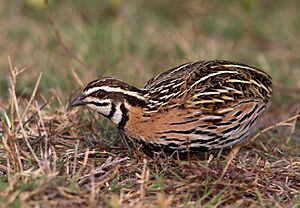Rain quail facts for kids
Quick facts for kids Rain quail |
|
|---|---|
 |
|
| Male | |
 |
|
| Female |
|
| Conservation status | |
| Scientific classification | |
| Genus: |
Coturnix
|
| Species: |
coromandelica
|
The rain quail or black-breasted quail (Coturnix coromandelica) is a small bird. It is a type of quail found in parts of Asia. You can find it in countries like Pakistan, India, Nepal, and Vietnam.
Contents
About the Rain Quail
The rain quail is a small bird, about 15 to 16.5 centimeters (6 to 6.5 inches) long. It weighs around 64 to 71 grams (2.25 to 2.5 ounces).
What Does It Look Like?
Male rain quails are easy to spot. They have a black patch on their chest. Their heads also have a special pattern of black and white markings. Female rain quails look a lot like other quail species. They are harder to tell apart. However, the spots on their chest are usually smaller and more delicate.
What Does It Sound Like?
The rain quail has a very clear call. It sounds like a metallic pair of quit- quit nots. They repeat this sound often. You can hear them calling in the mornings and evenings. During their breeding season, they even call at night. Their call is quite different from other quails.
Where Rain Quails Live
Rain quails live in grasslands and farm fields. They also like scrubland areas. You can find them in the Indus valley and across the Gangetic plains. These areas are in central Bangladesh, India, Nepal, and Pakistan. In winter, they often move further south.
Rain Quail Behavior
Rain quails eat seeds from grasses and other plants. They also like to eat insect larvae and small bugs.
Reproduction and Life Cycle
Rain quails usually breed between March and October. But they mostly start breeding after the monsoon rains begin in June. The female quail lays her eggs in a small dip in the ground. Sometimes, she hides the nest under a bush. A female usually lays six to eight eggs at a time. The eggs hatch after about 16 to 18 days. The baby quails, called chicks, can leave the nest very soon after hatching. They stay with their parents for about eight months.
Conservation Status
The rain quail lives in a very large area. Its population is stable, meaning there are many of them. Because it is a common species, the International Union for Conservation of Nature says it is of "least concern". This means they are not currently at risk of disappearing.
Rain Quails in Culture
In Khmer culture, which is from Cambodia, the rain quail is a special symbol. It is often shown in the middle of certain yantra cloth. These cloths are believed to bring good luck and protect homes.



